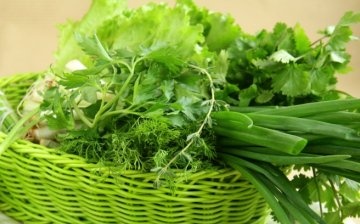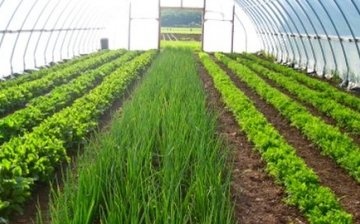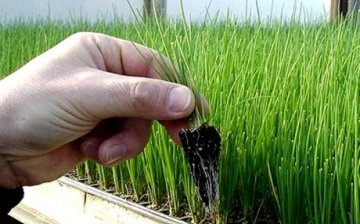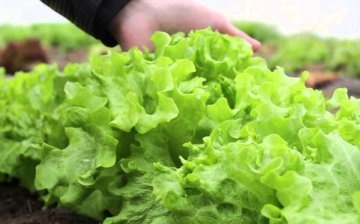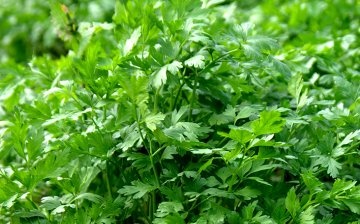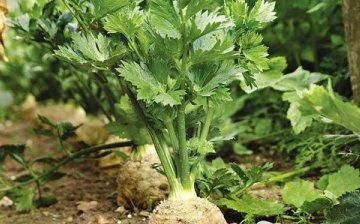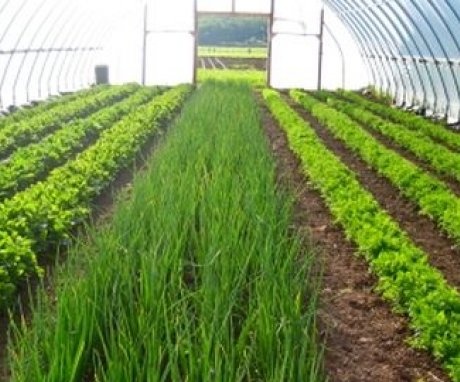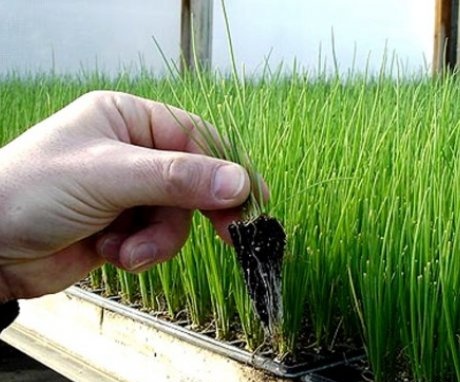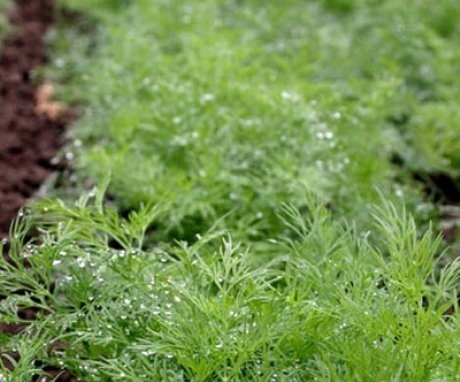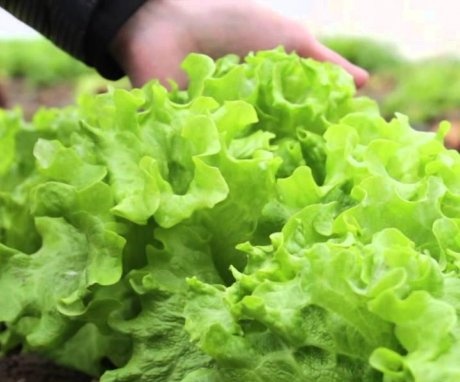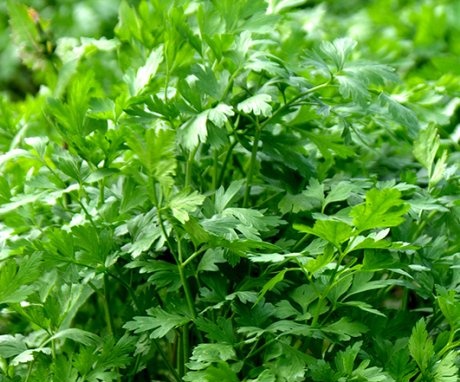Growing greens in a greenhouse - useful tips for a large harvest
Growing greenery in a greenhouse is rewarding and not very difficult. Greens are useful for the body all year round, and especially in the cold season.
Content
- Benefits of growing greenery in a greenhouse
- How to grow onions
- Growing dill
- Growing lettuce
- How to grow parsley
- Growing celery
Benefits of growing greenery in a greenhouse
In the greenhouse, you can harvest vegetables, fruits, and grow flowers. Some of the cultures are capricious in nature and require special knowledge and skills. Therefore, it is better to start with something simpler, for example, start growing greenery... After all, these plants are relatively unpretentious to growing conditions, and everyone needs vitamins all year round.
Advantages:
- Growing greenery does not require special skills, financial investments and labor.
- The period of ripening of products to the desired condition is relatively short, which makes it possible to take two or three harvests per year.
- You can plant greens at any time of the year.
Before sowing or planting plants, the characteristics and characteristics of each type of greenery are carefully analyzed, because they differ significantly. It's a good idea to learn some secrets to help you harvest much faster. Greens are plants in which the entire top is eaten.
The main and most requested:
- Onion
- Dill
- Salad
- Parsley
- Celery
Greenhouses are available with or without heating. For year-round cultivation of these species, it is imperative to take a heated one. After all, in winter there are usually severe frosts that will ruin the plants.
How to grow onions
The best varieties Luke for harvesting in autumn Massalinsky, Margelansky, Troitsky multi-germ Amber, Black Prince, Bessonovsky. At the beginning of winter, varieties from the Krasnodar Territory are grown. In the spring, preference can be given to Skopinsky, Timiryazevsky.
The planting material must be of high quality, the bulbs must be whole and healthy.
Growing rules:
- Rotted manure and compost are introduced, carefully dug up. Superphosphate and potassium chloride are added.
- There should be a distance of about 3 cm in a row, 7 cm between rows. Plants are watered.
- Closer to spring they bring fertilizerscontaining nitrogen.
Onions grown in this way are harvested in mid-May, when the feather height reaches 20 cm. You can cut them off or dig them up with the bulbs. This is a long process and is suitable for growing in unheated greenhouses. Here, manure is used as a warming material, with which the site is covered with the onset of cold weather.
You can harvest onions faster. For this, multi-primordial varieties are used. Sevok warms up to 40 ° С. The top is cut off to make it easier for the sprout to break through, a vertical incision is made there and planted. The harvest will be ready in a month. But for this it is necessary to maintain the temperature in the greenhouse room not lower than 18 ° С during the day and 12 ° С at night.
Growing dill
A very valuable crop for growing in a greenhouse - Dill... It is healthy and gives every dish a summer flavor. Dill is less demanding on the temperature regime, 15 ° C is enough. To control the temperature, devices are installed that determine the temperature not only of the air, but also of the soil. Seeds prepare for sowing, keeping for 12 hours in a weak solution of potassium permanganate. The essential oils covering the seeds will soften and it will be easier for the sprout to break through. Sow 3 cm.
To provide the dill with the right moisture, the dill is regularly sprayed with warm water.
The same plants are watered. The soil should be moderately moist before germination. Greenhouse ventilation must be done very carefully. The resulting draft can ruin the crop. Dill grows to harvest 40 days. They feed him with nitrophosphate, introducing it into the furrows when planting. During germination, the plant quickly absorbs phosphorus. It is better not to use nitrogen fertilizers so that the amount of nitrates does not exceed the permissible limits.
It is better to take varieties of an average ripening period. This is:
- Lesnogorodsky
- Abundant
- Bushy
In an unheated greenhouse, dill can be grown until November. In the spring, it is necessary to carry out a number of measures to increase the temperature of the soil and air inside the greenhouse. This is the covering of the area around the greenhouse and the soil inside it with black geotextiles. Double covering with a film will help, the use of stones that heat up from the sun during the day and give off heat in the evening.
Growing lettuce
Salad different varieties are unpretentious to growing conditions. It is quite cold-resistant, grows well under phytolamp lighting. So the watercress is ready to eat after 3 weeks. When growing cabbage salads, take into account the peculiarities of cultivation:
- The distance between plants is not less than 30 cm,
- They need more light
- Tough temperature regime
- It takes more time to form a head of cabbage.
Experts advise growing lettuce from autumn to December. The period from January to April is also favorable for growing this crop in a greenhouse.
Among the leaf varieties, the best are:
- Emerald lace
- Moscow greenhouse
- Parliament
Salad grows well in moist, loose soil. The soil should have a slightly acidic or neutral reaction. It can be achieved by adding lime to reduce acidity, and superphosphate and potassium chloride to increase it. In the soil consisting of humus, peat and sand, before sowing, you need to add mineral fertilizers (50 g / m2). Small salad seeds are sown to a depth of 1 cm.
Water before germination and immediately after the plants emerge from the ground.
The larger the plant becomes, the less often it is watered. Water is poured in the aisles in the morning. Lettuce leaves do not like water ingress. They are losing their presentation. Daytime temperature 18-20 ° С, at night 10 ° С is enough. You need to light the salad for at least 16 hours a day. Used for this phytolamps or, in the absence of, fluorescent lamps. They are more like the sun's rays. Supplementing with an ordinary light bulb will not help here. For rapid plant growth, you can feed a couple of times with nitrogen fertilizers. But you need to strictly adhere to the norm, not using more than 10 g / m2, so that a large amount of nitrates does not spoil the quality of the product.
How to grow parsley
Parsley more than other plants depend on the temperature regime. Although it tolerates low temperatures without freezing in winter under a layer of snow, its leaves will not grow in a greenhouse without heating. Therefore, it is grown there until December. In heated greenhouses, parsley is planted in January. Daylight hours at this time are already increasing significantly. The air temperature must be kept low, 12 ° C. With an increase from 20 ° C, it fades.
And parsley does not like temperature changes.
Humidity for its successful cultivation must be maintained at least 75%. The greenhouse can be ventilated, parsley is not afraid of drafts. Watering is necessary only as the soil dries up. When growing parsley use artificial lighting.
The soil for growing parsley needs light, otherwise the roots may turn out to be clumsy. Sod-podzolic and light loamy soils are suitable. The plant is undemanding to fertilization.
Parsley is grown from seed or root vegetables:
- The first method is simpler, but it takes much more time. Matured for 5 days in a damp cotton cloth or sand, the seeds are sown in the ground. Seed hardening for 10 days can significantly speed up the growing process. Maintain a temperature of 1 ° C. Sow seeds. Seedlings are thinned out, leaving one plant per 5 cm.
- I choose small roots for forcing, up to 5 mm thick. If the root is very long and it will be inconvenient to plant it, cut it to 8 cm. The leaves are removed. The roots are immersed in wet sand, where they are kept for 10 days at 2 ° C. Then they are laid in the prepared grooves, tilting them at an angle of 45 °. Sprinkle with soil so that the top of the root crop is on the surface. The plantings are watered regularly. The air temperature when growing parsley is 15 ° C. You can cut the leaves in a month, when they grow 25 cm. The yield is about 1.5 kg / m2.
Growing celery
Celery not as popular as onion or dill or salad, but it surpasses many of them in medicinal properties. Celery is leafy, root and petiolate. Usually, root is grown for greens in a greenhouse.
The leaves of an adult celery plant with a formed root crop are quite tough. And they get them from a square meter to 4 kg. In order to avoid this drawback, the leaves are cut three times. At the same time, the yield rises to 7 kg / m2. And the greens themselves become much tastier, more tender. The content of carotene increases slightly.
Greenhouse varieties:
- Apple delicacy
- Root Gribovsky.
Celery is grown from seeds in a greenhouse:
- Seeds germinate before sowing.
- Sow about 2 g / m2.
- Shoots appear in a week. After sowing, the temperature is maintained up to 20 ° C during the day, and up to 12 ° C at night.
- After the seeds have sprouted, for a week they are lowered to 14 ° C during the day, and to 6 ° C at night. The entire subsequent period maintain the temperature at 18 ° C during the day, and 14 ° C at night.
- Humidity is maintained all the time in the range of 60-70%.
- The amount of harvest directly depends on the length of daylight hours, so it should be as long as possible. Supplementary illumination with phytolamps is used.
- In the phase of 1-3 true leaves, plants are dived into peat pots, or unpicked plants with 3-5 leaves are planted in the ground. Distance in a row 15 cm.
- It takes up to 70 days from sowing seeds to planting them in the soil.
Video on how to properly grow lettuce in a greenhouse.
Growing celery from root vegetables:
- Celery greens are grown from pre-prepared root crops with a diameter of about 8 cm and petioles of 3 cm.
- After the leaves are cut off during storage before planting, many lateral buds form on the root crop.
- Water the soil well before planting.
- The consumption of root crops per square meter is up to 7 kg.
- The soil should be light and fertilized.
- For feeding cow dung or bird droppings can be used. It is carried out in each of the periods of leaf regrowth.
Cutting the greens is carried out after it reaches a height of 30 cm. Again, 3 cm roots are left. For the third time, the roots are dug up along with the herbs. True, not all of them survive until the third harvest. Some of them disappear earlier. Therefore, the last harvest is usually much lower than the first two. But on the other hand, the quality of products during the cultivation process is much higher than with a one-time harvest.
Growing greenery is a fun and rewarding experience. Its secrets are easy to comprehend. And the result obtained will delight you and your loved ones.



